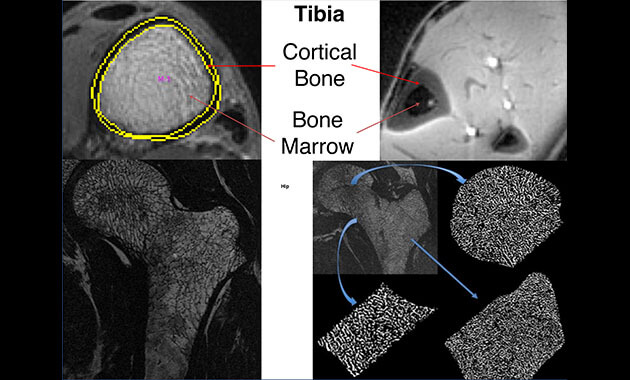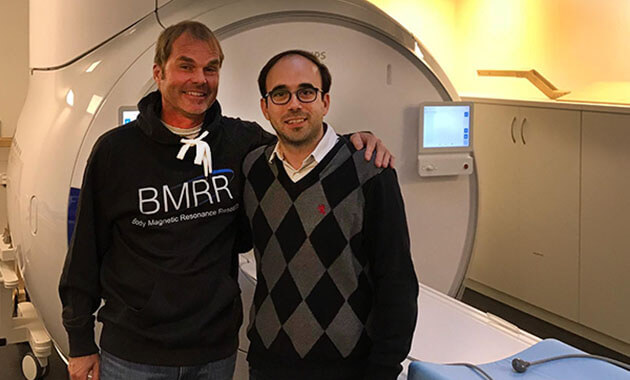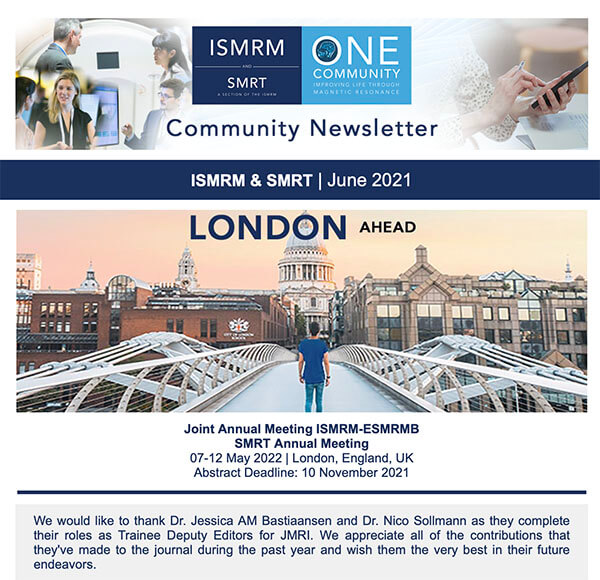Musculoskeletal Magnetic Resonance Imaging Lab (Krug Lab)
The Musculoskeletal Magnetic Resonance Imaging Lab's main research interest relates to the assessment (MRI) and treatment (MR guided Focused UltraSound FUS) of lower back pain. Furthermore, we assess bone and bone marrow health, obesity and whole body composition, and osteoarthritis in various patient populations. In particular, we develop methods to assess:
- Lower Back Pain (Biochemical Assessment of the Spinal Endplate using UTE, Intervertebral Disc T1rho, and Bone Marrow using Dixon).
- Whole Body Composition (Visceral Adipose Tissue, Subcutaneous Adipose Tissue, Intramuscular Adipose Tissue, Muscle Volumes).
- Osteoporosis (Bone and Bone Marrow Quality in Hip, Wrist, Ankle, and Knee).
- Bone Hydration and Porosity.
- High-Intensity Focused Ultra-sound (HIFU) for the Treatment of Lower Back Pain.
- Osteoarthritis (Assessment of the Calcified Cartilage Layer in the Knee).
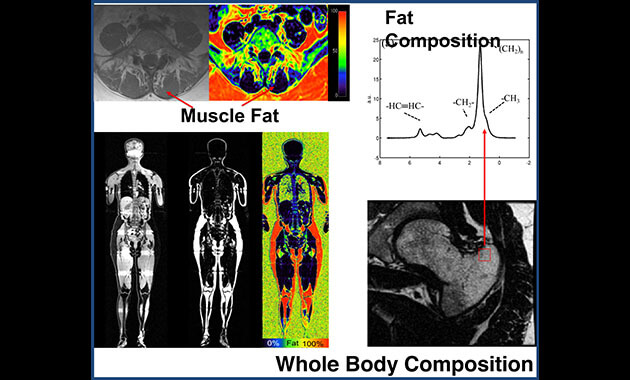 Whole body composition: Whole body Dixon magnetic resonance imaging is a quick, radiation-free alternative to DXA and CT in measuring whole-body composition.
Whole body composition: Whole body Dixon magnetic resonance imaging is a quick, radiation-free alternative to DXA and CT in measuring whole-body composition.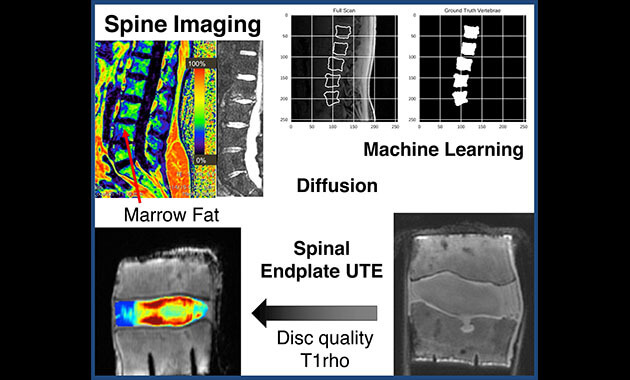 Spine imaging: We are working to establish non-invasive markers of spinal disc degeneration and a comprehensive set of biomarkers for characterizing lower back pain, using magnetic resonance imaging methods such as UTE, T2 and T1rho, diffusion and spectroscopy.
Spine imaging: We are working to establish non-invasive markers of spinal disc degeneration and a comprehensive set of biomarkers for characterizing lower back pain, using magnetic resonance imaging methods such as UTE, T2 and T1rho, diffusion and spectroscopy.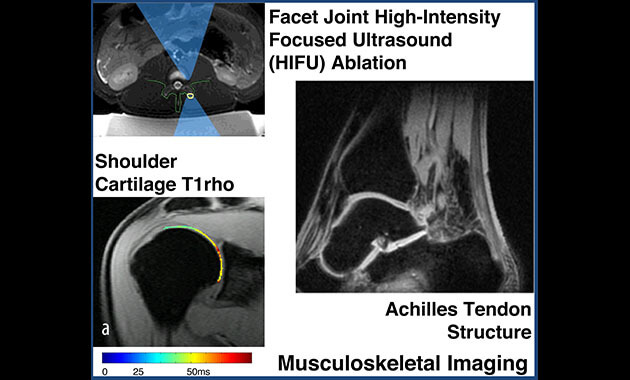 Musculoskeletal imaging: Musculoskeletal magnetic resonance imaging involves traditional structural imaging, but now includes more advanced techniques such as MR Focused Ultrasound (MR-FUS), T1rho quantification, and Ultrashort Echo Time (UTE) to name a few.
Musculoskeletal imaging: Musculoskeletal magnetic resonance imaging involves traditional structural imaging, but now includes more advanced techniques such as MR Focused Ultrasound (MR-FUS), T1rho quantification, and Ultrashort Echo Time (UTE) to name a few.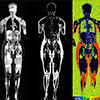
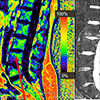
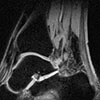
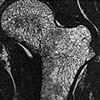
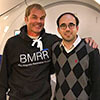

News
Congratulations to Nico Sollmann for his work as a Trainee Deputy Editor of JMRI
June 2021
Journal of Magnetic Resonance Imaging (JMRI) Newsletter - June 2021 (pdf)
Research Published in Frontiers Endocrinology
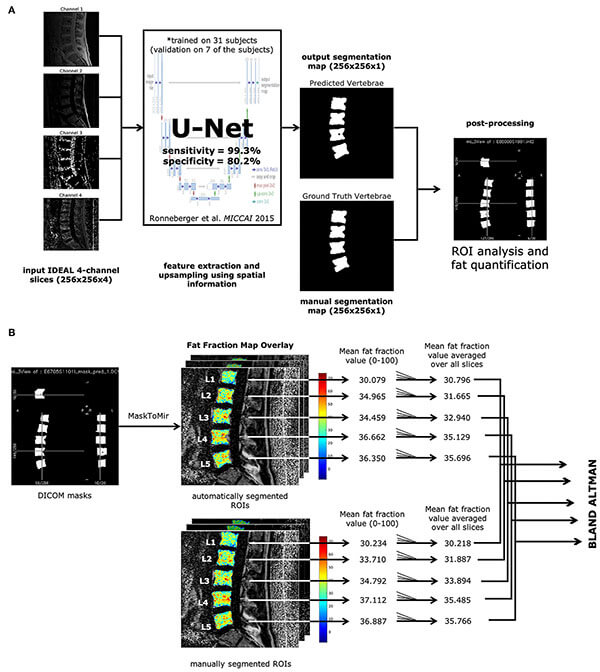
The Krug Lab receives several NIH grants (>$30M) to study low back pain and opioid addiction
October 10, 2020
Featured it in UCSF News. Dr. Krug is the imaging director of the Core Center for Patient-centric Mechanistic Phenotyping in Chronic Low Back Pain (https://www.bacpac-reach.org/people-1) at UCSF (U19) as well as PI on a technogloy center (UH2/3).
 The Krug Lab's work is featured on the Cover of JMRI
The Krug Lab's work is featured on the Cover of JMRI
October 2019 edition
Krug R et al. Associations between vertebral body fat fraction and intervertebral disc biochemical composition as assessed by quantitative MRI. JMRI 2019 Oct;50(4):1219-1226.
Body MR Imaging Group in Munich
September 2019
Visiting Professor at the Technical University of Munich. The Body MR Imaging group (BMRR) in Munich lead by Prof. Dimitrios Karampinos (image below right) is a strong collaborator of our laboratory.
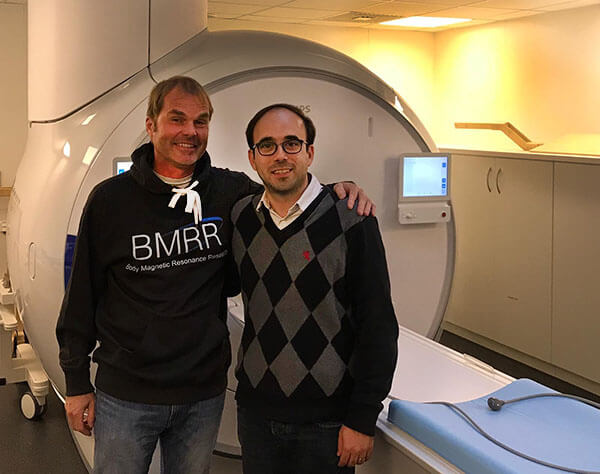
Celebration of 15 years at UCSF with Department Chair and Dean
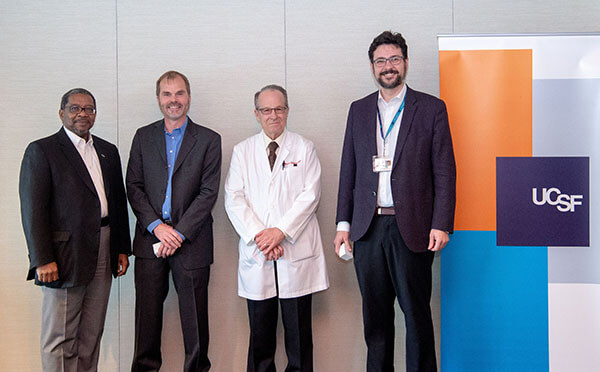
Oral Presentations and Podium Talks
- ISMRM 2019 workshop on Obesity Singapore (Invited Talk)
- ISTU/EFUS 2019 in Barcelona. SI Joint pain ablation using MRgFUS. (Krug et al.)
- ORS 2018 in New Orleans. Quantitative MRI in patients with lower back pain (Krug et al.)
- ISMRM 2018 in Paris. Relationship of vertebral fat, and disc health in patients. (Krug et al.)
- ASBMR 2018 in Montreal, Canada. Bone Marrow Fat and its Associations with Bone Quality in the Proximal Femur. (Krug et al.)
- FUS Foundation 2018 in Virginia. MRgFUS for back pain. (Rieke, ..., Krug)
Featured on the Cover of QIMS (Feb 2018 edition)
G.J. Kazakia, J. Carballido-Gamio, A. Lai, L. Nardo, L. Facchetti, C. Pasco, C.A. Zhang, M. Han, A. Hutton Parrott, P. Tien, R. Krug. "Trabecular Bone Microstructure is Impaired in the Proximal Femur of HIV-Infected Men with Normal Bone Mineral Density"
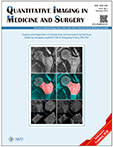
Oral Presentation at the ORS 2018 in New Orleans
Krug et al.: Associations between Disc Biochemical Composition and Vertebral Body Fat Fraction using Quantitative MRI.
Research on Hip Osteoporosis featured on the title page of JMRI (May 2015 edition)
Han M, Chiba K, Banerjee S, Carballido-Gamio J, Krug R. "Variable flip angle three-dimensional fast spin-echo sequence combined with outer volume suppression for imaging trabecular bone structure of the proximal femur"
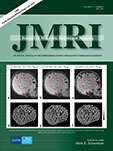
Publications
- Zhou J, Damasceno PF, Chachad R, Cheung JR, Ballatori A, Lotz JC, Lazar AA, Link TM, Fields AJ and Krug R (2020) Automatic Vertebral Body Segmentation Based on Deep Learning of Dixon Images for Bone Marrow Fat Fraction Quantification. Front. Endocrinol. 11:612.
- R. Krug, G.B. Joseph, M. Han, A. Fields, J. Cheung, M. Mundada, J. Bailey, A. Rochette, A. Ballatori, Ch. McCulloch, Z. McCormick, C. O’Neill, Th. Link, J. Lotz. Associations between Vertebral Body Fat Fraction and Intervertebral Disc Biochemical Composition as assessed by Quantitative MRI. (JMRI 2019 in press).
- G.J. Kazakia, J. Carballido-Gamio, A. Lai, L. Nardo, L. Facchetti, C. Pasco, C.A. Zhang, M. Han, A. Hutton Parrott, P. Tien, R. Krug. "Trabecular Bone Microstructure is Impaired in the Proximal Femur of HIV-Infected Men with Normal Bone Mineral Density"
- R. Krug, L. Do, V. Rieke, M.W. Wilson, M. Saeed. Evaluation of MRI Protocols for the Assessment of Lumbar Facet Joints after MR-Guided Focused Ultrasound Treatment. Journal of Therapeutic Ultrasound 6;4:14. (2017). PMCID: PMC4822243.
- E. Ozhinsky, M. Han, M. Bucknor, R. Krug, V. Rieke. T2-Based Temperature Monitoring in Bone Marrow for MR-guided Focused Ultrasound. Journal of Therapeutic Ultrasound (2017 in press).
- M. Bucknor, E. Ozhinsky, R. Shah, R. Krug, V. Rieke. The Effect of Sonication Duration and Power on Ablation Depth during MR-Guided Focused Ultrasound of Bone. JMRI (2017 in press).
- D. Lansdown, S. Lee, C. Sam, R. Krug, B. Feeley, C.B. Ma. A Prospective, Quantitative Evaluation of Fatty Infiltration Before and After Rotator Cuff Repair. OJSM (2017 in press).
- D.C. Karampinos, S. Ruschke, M. Dieckmeyer, M. Diefenbach, D. Franz, A.S. Gersing, R. Krug, Th. Baum. Quantitative magnetic resonance imaging and spectroscopy of bone marrow. JMRI (2017 in press).
- B. Berg-Johansen, M. Han, A.J. Fields, E.C. Liebenberg, B.J. Lim, P.E.Z. Larson, C. Gunduz-Demir, G.J. Kazakia, R. Krug, J.C. Lotz. Cartilage Endplate Thickness Variation Measured by Ultrashort Echo-Time MRI is Associated with Adjacent Disc Degeneration. Spine (2018 in press).
- G.J. Kazakia, J. Carballido-Gamio, A. Lai, L. Nardo, L. Facchetti, C. Pasco, C.A. Zhang, M. Han, A. Hutton Parrott, P. Tien, R. Krug. Trabecular Bone Microstructure is Impaired in the Proximal Femur of HIV-Infected Men with Normal Bone Mineral Density. QUIMS; 8(1):5-13. (2018).
See a complete list of published work in MyBibliography
Research Projects
Quantifying Temperature Changes in Bone
We have recently published our research on temperature assessment of bone during heating. The goal of this research is to monitor temperature in bone in-vivo during high intensity focused ultrasound (HIFU) ablation.
High Resolution Assessment of Bone Marrow Fat Content
Our group has been pioneering the assessment of bone marrow fat content in the presence of trabecular bone with high spatial resolution. We have recently evaluated this technique in phantoms and compared in-vivo with MR spectroscopy:
- C. Gee, J. Nguyen, C. Marquez, J. Heunis, A. Lai, C. Wyatt, M. Han, G. Kazakia, A. Burghardt, D. Karampinos, J. Carballido-Gamio, R. Krug. Validation of Bone Marrow Fat Quantification in the presence of Trabecular Bone using MRI. JMagnResonImaging (2015 in press).
- D. Karampinos, G. Melkus, Th. Baum, J. Bauer, E.Rummeny and R.Krug. Bone marrow fat quantification in the presence of trabecular bone: Initial comparison between water-fat imaging and single-voxel MRS. Magn Reson Med. Volume 71, Issue 3, pages 1158–1165, March 2014.
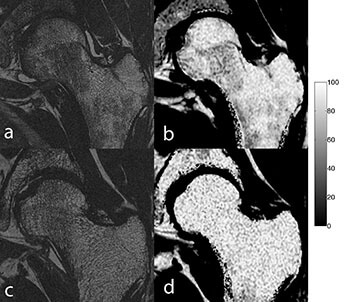
Figure shows typical in-vivo examples of high-resolution MRI images along with corresponding MRI Fat Fraction maps. The top row shows images from a young, healthy female. Image a) depicts the trabecular structure and image b) the corresponding Fat Fraction map. The high-resolution image shows a dense trabecular structure. The darker, hematopoietic bone marrow is clearly depicted and can be quantified on the Fat Fraction map b). The bottom row shows images from a postmenopausal woman who sustained a low impact fracture. The high-resolution image c) shows dense bone but the Fat Fraction map d) also reveals overall high bone marrow fat content as compared to b) where large areas of hematopoietic bone marrow are present.
Assessment of Temperature in Bone using MRI
We have recently shown for the first time that temperature changes can be measured in bone during heating using T1-UTE based MR imaging. We have presented these results at ISTU 2014 and ISMRM 2014 in oral presentations.
Bone Marrow Fat Fraction Mapping in the Proximal Femur in vivo using IDEAL
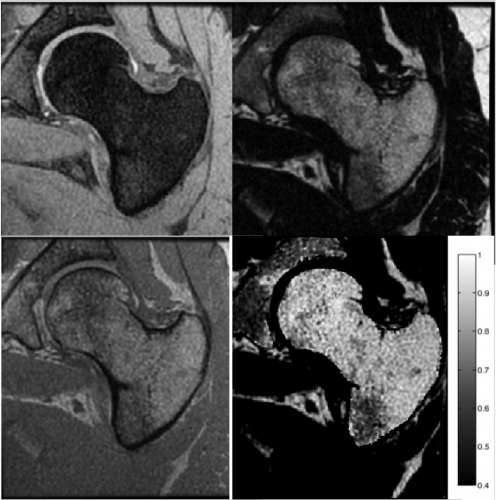
Figure: Clockwise from top left: Water only image, Fat only image, Fat Fraction Image and In-Phase image.
(D. Karampinos, R. Krug)
There is some evidence that osteoporosis is associated with increased marrow fat content as well as a conversion from red marrow to yellow (fatty) marrow with age. In this project, we investigate the marrow fat composition in the proximal femur in vivo using a method based on Iterative Decomposition of water and fat with Echo Asymmetry and Least-Squares Estimation (IDEAL). Three-point IDEAL FGRE hip images of six healthy subjects were acquired and water-fat separation was performed using multi-peak IDEAL. The average fat fraction and standard deviation were determined in three different regions of interest (femoral head, trochanter and neck). Significant differences in marrow fat content were identified between the three regions for all subjects.
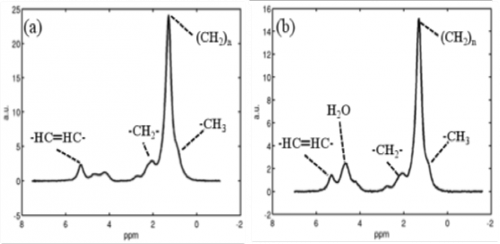 Figure 1: Comparison of single-voxel PRESS MR spectra from the trochanteric region (left) and the neck region (right). Note the enhanced water peak on the right spectrum.
Figure 1: Comparison of single-voxel PRESS MR spectra from the trochanteric region (left) and the neck region (right). Note the enhanced water peak on the right spectrum.
Advanced Image Analysis Techniques of New High-resolution Images of the Proximal Femur in the Presence of Red and Yellow Bone Marrow using Local Bone Enhancement Fuzzy Clustering
(J. Folkesson, R. Krug)
Using advanced MR hardware and pulse sequences technique, we have been able to image the small trabecular structure of deeper sited seated regions like the proximal femur with very high spatial resolution in a clinically feasible scan time. We have developed and employed a novel partial membership bone segmentation technique (BE-FCM) that enhances bone segmentation compared to an established dual thresholding method in the presence of signal variations due to different marrow types. The new image acquisition and analysis framework enables trabecular bone analysis in the deeply situated femoral head, something which has been previously unfeasible in vivo.
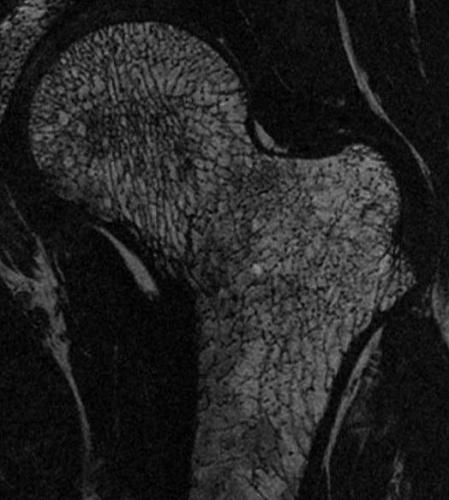 Figure 2: High-resolution in vivo image of the proximal femur. Hemopoietic or red marrow is composed of ~40% water (longer T1) and appears dark (femoral head, neck and shaft). The more prevalent yellow marrow is more fatty and yields a brighter MR signal.
Figure 2: High-resolution in vivo image of the proximal femur. Hemopoietic or red marrow is composed of ~40% water (longer T1) and appears dark (femoral head, neck and shaft). The more prevalent yellow marrow is more fatty and yields a brighter MR signal.
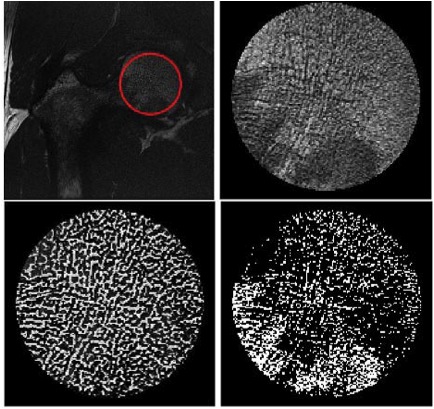 Figure 3: Top images: ROI defined in the femoral head. Bottom image (left): Trabecular bone segmentation of the ROI using the advanced BE-FCM technique. Bottom image (right): The same ROI segmented using an established dual thresholding technique.
Figure 3: Top images: ROI defined in the femoral head. Bottom image (left): Trabecular bone segmentation of the ROI using the advanced BE-FCM technique. Bottom image (right): The same ROI segmented using an established dual thresholding technique.
Opportunities
Post-doctoral Opportunities
- Research Directory
- Abdominal Imaging Research
- Abdominal and Pelvic MRI
- Arthritis Imaging Lab (Li Lab)
- Baby Brain Research Group
- Biomagnetic Imaging Laboratory
- Biomechanics & Musculoskeletal Imaging Lab
- Bone Quality Research Lab
- Brain Arteriovenous Malformations
- BrainChange Study
- Breast Imaging Research Group
- Breast and Bone Density Group
- Cardiothoracic Imaging Imaging Research
- Center for Molecular and Functional Imaging (CMFI)
- Contrast Material and CT Translational Research Lab
- Daniel B. Vigneron Lab
- Evans Lab
- Focused Ultrasound Lab
- High Field MRI Center
- Imaging Research for Neurodevelopment
- Interventional Radiology Research Lab
- Larson Group
- Lupo Lab
- Majumdar Lab
- Molecular Imaging Lab (Flavell Lab)
- Multimodal Metabolic Brain Imaging
- Musculoskeletal Magnetic Resonance Imaging Lab (Krug Lab)
- Musculoskeletal Quantitative Imaging Research
- Neural Connectivity Lab
- Neuroradiology Research
- Osteoid Osteomas HIFU Clinical Trial
- PET/SPECT Radiochemistry
- PSMA PET Scan
- Pediatric Research
- Physics Research Laboratory
- Program for Molecular Imaging and Targeted Therapy
- Prostate Cancer Imaging Lab (Kurhanewicz)
- Research
- Sarah J. Nelson Lab
- Surbeck Laboratory
- Translational Metabolic Imaging Lab
- UCSF Nuclear and Clinical Molecular Imaging Research
- Vascular Imaging Research Center
- Viswanath Ronen Lab
- Wilson Lab
- Imaging Research Symposium
- Research Conference
- UCSF Radiology at RSNA
- Core Services
Krug Lab Contact
PI, Roland Krug, PhD
Ph.: (415) 353-4945
Fx: (415) 353-9423
Email: [email protected]

